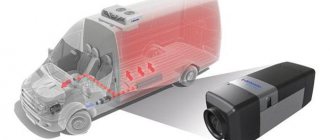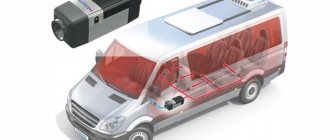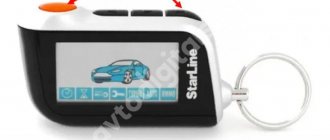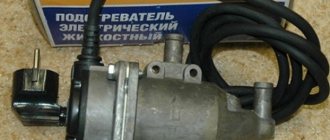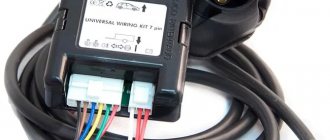Webasto is a pre-heater for a car engine , which ensures easy starting in the cold season. However, during long-term operation, like any other device, the heater may experience various types of malfunctions that interfere with its proper operation. In this regard, most car owners are interested in the reasons why Webasto does not start. Before encountering this kind of problem, you first need to understand the principle of operation and what problems may arise.
Design and principle of operation
The preheater consists of five components:
- Electronic control unit;
- The combustion chamber;
- Heat exchanger;
- Circulating pump;
- Fuel lift pump.
Main components and operation diagram of Webasto
Webasto can be launched both from inside the car and using the control panel from a distance of up to one kilometer.
The fuel booster pump from the fuel tank supplies a portion of fuel to the combustion chamber, which is ignited by a spiral spark plug. There is a heat exchanger in the combustion chamber, which is washed by coolant. The heat exchanger is connected to a small circle of the engine cooling system, and thanks to a circulating pump, coolant circulates through the cooling jacket, which helps warm up the engine faster before starting. And an electronic control unit connected to the engine electronic control unit controls the operation of the heater.
Webasto DBW 2010/2012/2020/2022/300/350
Preliminary diagnostics of faults in engine pre-heaters for Webasto DBW 2010/12, 2020/22 and Webasto 300/350.
| Malfunction | Check and repair or replace if necessary |
| After switching on, the heater does not work. | Electricity supply. Circuit breakers. Electrical wires and connections. Switch. Control block. |
| The operating mode display goes out after approximately 25 seconds. | Temperature fuse or heat limiter. Flame detector. Control block. Ignition electrodes. Ignition spark source, ignition cable. Drive (motor). Fuel supply. Fuel pump. Fuel solenoid valve. Spray nozzle. |
| The motor in the heater does not work. | Electricity supply. Circuit breakers. Electrical wires and connections. Heating control thermostat or temperature sensor. Control block. Drive (motor). |
| Engine in a heater – absence of an initial phase preceding combustion. | Electricity supply. Control block. |
| The engine is in the heater - no purge after finishing work. | Control block. |
| Circulation pump does not work. | Electricity supply. Circuit breakers. Electrical wires and connections. Control block. Drive (motor). |
| There is no ignition spark. | Circuit breakers. Electrical wires and connections. Flame detector. Control block. Ignition spark source, ignition cable. |
| Combustion – does not start after 15 seconds. | Temperature fuse or heat limiter. Flame detector. Control block. Ignition electrodes. Ignition spark source, ignition cable. Fuel pump. Fuel solenoid valve. Spray nozzle. |
| Combustion – Combustion stops after 25 seconds. | Electricity supply. Electrical wires and connections. Flame detector. Control block. |
| Combustion – cannot be turned off. | Switch. Control block. Fuel solenoid valve. |
| Combustion – with light smoke. | Fuel supply. Fuel pump. Spray nozzle. |
| Combustion – with dark smoke. | Electricity supply. Electrical wires and connections. Drive (motor). Fuel supply. Combustion air supply. Exhaust gas removal. |
| The preheater is overheated. | Electrical wires and connections. Temperature fuse or heat limiter. Temperature fuse or heat limiter. Heating control thermostat or temperature sensor. Control block. Spray nozzle. Heating system. |
Webasto malfunctions and their elimination
The main malfunctions include the following reasons:
- The heater does not start;
- Refusal to work;
- After starting, the heater stops.
Webasto does not start depending on the quality of the equipment, as well as the quality of the fuel. You need to start from the fact that either there is nothing to set on fire, or there is nothing to burn, and in some cases, both are possible. Poor quality fuel clogs the filter mesh of the fuel pump, resulting in poor dosage, and subsequently a complete lack of supply. Also, poor fuel has a detrimental effect on the spark plug, which becomes heavily coked and stops heating to the required temperature, and then becomes unusable.
In case of failure of the electronic control unit, it is better to contact a service center for diagnostics with special software.
Webasto malfunctions on diesel engines are similar to those for cars with gasoline engines. On a diesel engine, Webasto may not start due to the fact that it is often difficult to find good quality diesel fuel, and the sulfur content is higher than normal, polluting the spark plug even more than gasoline. Accordingly, on a diesel engine it fails faster. Also, with a diesel engine, Webasto does not start in cold weather due to thickening of the fuel, which may simply not reach the supply system into the combustion chamber through the pipeline. Therefore, the fact that Webasto does not start in cold weather is a common problem on cars with diesel engines. Another Webasto malfunction is that the fuel pipe is bent; because of this, fuel will also not be able to flow into the heater. And the most common reasons why Webasto may not work are: clogged fuel grid and unusable glow plug. If Webasto does not turn on, the reason may be a failure of the electronic control unit. And when Webasto starts up at first, then stalls after some time, the problem may also be in the electronics. In these cases, you need to contact a service center, where the heater will be connected to a device with special software and diagnostics will be carried out.
PLANAR D4 error codes
| Number of LED blinks | Description of the error |
| 1 | Overheat |
| 2 | The heater does not start (two automatic start attempts have been exhausted) |
| 3 | Flame failure |
| 4 | Glow plug malfunction |
| 5 | Flame indicator fault |
| 6 | Malfunction of the temperature sensor in the control unit |
| 7 | Fuel pump malfunction |
| 8 | The heater does not start |
| 9 | Shutdown, overvoltage over 30.8 V (15 V for 12 V heater) |
| Shutdown, undervoltage less than 20 V (10.8 for 12 V heater) | |
| 10 | Ventilation is insufficient to cool the heater combustion chamber |
| 11 | Blower motor malfunction |
Webasto errors
Diagnostics and reset of Webasto errors on a computer
During heater malfunctions, an error is generated in the control unit, which is stored in the internal memory. When it is faulty, the indicator lamp flashes a specified number of times after a while. Depending on how many times the lamp flashes, this will be the Webasto error code. If you correctly determine this code, you can understand the cause of the malfunction and how to eliminate it.
Webasto fault codes are given in the instructions that come with the heater, which indicates which code corresponds to which fault. After fixing the problem, the Webasto error must be reset, otherwise the device will not start. This is mainly done by connecting the heater to a computer and erasing it through special software.
REMOVAL OF EMERGENCY LOCK
Relevant for Webasto Air Top heaters:
- Webasto Air Top 2000/ 2000 Diagnose/ 2000S
- Webasto Air Top 2000 ST/ 2000 STC
- Webasto Air Top 3500 / 5000
- Webasto Air Top 3500 ST / 5000 ST
- Webasto Air Top Evo 3900 / Evo 5500
- Webasto Air Top Evo 40 / Evo 55
The heater goes into an emergency blocking state if several (6–20) faults of the same type occur in a row (see more details below).
To remove the emergency lock you need to:
- 1. Turn on the heater using the control (error code F12 or 07 will be displayed, or the LED will flash 12 times).
- 2. De-energize the heater (remove the power fuse protecting the heater control unit, or de-energize the heater in any other convenient way, including removing the battery terminal).
- 3. Turn off the heater control.
- 4. Wait at least 10 seconds.
- 5. Restore the power supply to the heater (replace the power fuse, or restore the power circuit in another way).
- 6. Turn on the heater using the control again.
Emergency shutdown.
During the startup process and throughout the operation of the heater, the control unit checks its components for faults.
In case of the following malfunctions, it turns off (blocks) the heater:
- • Lack of combustion or error at startup
- • Damage to the temperature sensor
- • Interruption (break) or short circuit of the overheat sensor
- • Incorrect installation of the overheating sensor
- • Interruption or short circuit of the glow pin/flame sensor.
- • Interruption or short circuit in the blower motor circuit or incorrect speed.
- • Interruption or short circuit in the metering pump circuit
- • Undervoltage below 10/21 V for more than 20 seconds.
- • Increased voltage above 16/32 V for more than 6 seconds
- • Malfunction of the control unit itself
- • Overheating
For more details, see “Webasto Air Top - error codes.”
If the heater overheats, the fuel supply stops. Turning off the heater during an emergency shutdown occurs in the same way as usual. After turning off the heater, a fault code is issued to the control (in the form of a code of type F11 for controls of type 1531, by blinking of the LED on the switch - slow blinks separated by several fast ones, or a hexadecimal code on Multicontrol controls).
To remove the blockage, the heater must be turned off for at least 2 seconds and turned on again.
Error overview.
For more details, see “Webasto Air Top - error codes.”
Errors such as overheating, startup error and flame failure are stored in the memory of the control unit and, when the maximum possible number is reached, can cause the heater to be blocked.
- • Startup error (FSZ) is counted every time the heater fails to start. If the number of these errors is 9, the heater is blocked (HGV).
- • If the same error (SZ) is repeated more than 5 times, the heater is blocked. (HGV)
- • If overheating (UHZ) occurs more than 5 times, the heater is blocked (HGV)
- • After a flame failure (FAZ), restart is carried out automatically. The reason for this is that the heater was previously in control mode. During a restart, the cycle repeats (ZWZ). This process is repeated until the heater either starts or the number of cycle repetitions reaches 3.
- • In case of flame failure (FAZ), the cycle is automatically repeated (ZWZ). If the cycle (ZWZ) is repeated more than 3 times, the heater is blocked (HGV).
- • Automatic reset: After each heater start, the cycle repeat counter ZWZ is reset to zero. The fault counter during normal operation becomes zero, and the counters for flame failure FAZ, overheating UHZ, unsuccessful starts FSZ after correct operation in combustion mode for more than 6 minutes are reset to zero.
Decoding abbreviations
- ZWZ – cycle repeat counter
- FAZ – flame break
- UHZ - overheating
- FSZ – bad start
- HGV – heater blocking
- SZ – fault counter
Eberspacher fault codes
Disconnect the plug connection heater/cable harness, start the vehicle engine, measure the voltage. Plug B1, pin C2 and C3:
Disconnect the plug connection heater/cable harness, start the vehicle engine, measure the voltage. Plug B1, pin C2 and C3:
– If the voltage is 70 K.
Pump out the air from the heating device (lack of water), open the heating damper and check the mass flow of water.
Measure the ohmic resistance of the temperature sensor, plug B5, pins 14 and 18, see page 28 for measurement values.
Apply the appropriate voltage and measure the current after 25 or 30 s. Plug B5, pin 2 and 7:
The following values indicate that the electrode pin is OK; if the values deviate, replace the probe electrode (see page 24).
at 8 V after 30 s = 12 A ±1.0 A
at 18 V after 25 s = 5.3 A ±0.8 A
Check the combustion air blower motor by applying 8 V or 18 V supply voltage to the motor. Plug B5, pin 1 and 4:
The air blower motor into the combustion chamber does not rotate - replace the motor with a built-in sensor.
Turn on the heating, check the voltage and power supply to the sensor. plug B5, pin 10 and 5:
set value = 5 V
If there is any deviation, replace the control unit (see page 24).
measure the voltage with the blower running using an analog voltmeter
Plug B5 pin 13 and 5
Setpoint: Average 4V (+/- 0.3) (8V square wave).
If there is a deviation, replace the combustion air blower motor along with the built-in sensor.
If the sensor signal is OK, then the speed controller is faulty
Error codes WEBASTO AirTop 2000/3500/5000
| Code | Malfunction |
| F00 | the control unit is faulty (for AT 3500/5000) |
| F01 | no start (after 2 attempts) or (AT 3500/5000) no flame is formed |
| F02 | flame breakage (repeated more than 5 times) |
| F03 | voltage drop below permissible or increase above permissible |
| F04 | premature flame detection |
| F05 | open circuit or short circuit of the flame sensor (for AT 2000 and AT 2000S) |
| F06 | open circuit or short circuit of temperature sensor |
| F07 | open circuit or short circuit of the dosing pump |
| F08 | Open circuit, short circuit or incorrect air blower motor speed |
| F09 | open circuit or short circuit of the glow pin/flame sensor |
| F10 | overheat |
| F11 | open circuit or short circuit of the heating limiter (AT 3500/5000) |
| F12 | open circuit or short circuit of the control thermostat (AT 3500/5000) |
Why Webasto does not turn on: possible reasons
Webasto is an indispensable thing in the modern world. Happy owners of such a device avoid serious problems in winter. But as soon as the system disappears, the question arises, why does Webasto not turn on? In the article we will try to analyze the possible causes of the breakdown, but first we will look at how to use the mechanism correctly so as not to experience further problems with the heater.
Webasto system in a car
DIY repair
In the summer, no one uses this device, because there is no particular need for it. But then the first cold weather arrives, the driver presses the button, but there is no result. And self-diagnosis begins. The driver tries to detect the problem, and often fails. But still, independent repair of Webasto is possible, although the manufacturer recommends that you contact the company’s diagnostic center for any breakdowns. If you understand how the system works and have the necessary knowledge, you can repair the device yourself.
What is Webasto? Distinctive features
Today it is difficult to find a car enthusiast who does not dream of integrating Webasto into his car. Webasto is an autonomous pre-start heater made in Germany. A compact mechanism weighing 5 kg is installed inside the cooling circuit of the vehicle’s on-board network and fuel system. The main function of Webasto is to warm up the engine before starting the power unit. An autonomous heater pump drives antifreeze throughout the cooling network through the radiator. Essentially, the device is a small combustion chamber connected to the vehicle’s cooling system. Today, the manufacturer is bringing two types of devices to the market - Thermo Top Evo-4 and Thermo Top Evo-5 . They differ only in power.
Webasto is also connected to the standard interior heater and starts the fan. Thus, in the cold season, the driver does not need to wait for the engine to warm up. The motor reaches the required temperature with one press of the remote control button. The owner does not need to approach the car; Webasto can be launched from the apartment window. In addition, during a cold start, engine wear is equal to a mileage of 100 km . The heater works autonomously, heating and starting the engine for a long time does not take up a large battery charge. The only obvious downside is that the battery life is reduced by a year. If we take this as a price for convenience and comfort, then changing the battery is not decisive.
Webasto operation in winter
Reset errors on Webasto Thermo Top Evo
This entry is more like a note for myself, I don’t pretend to be the truth. But it will be great if it helps anyone
